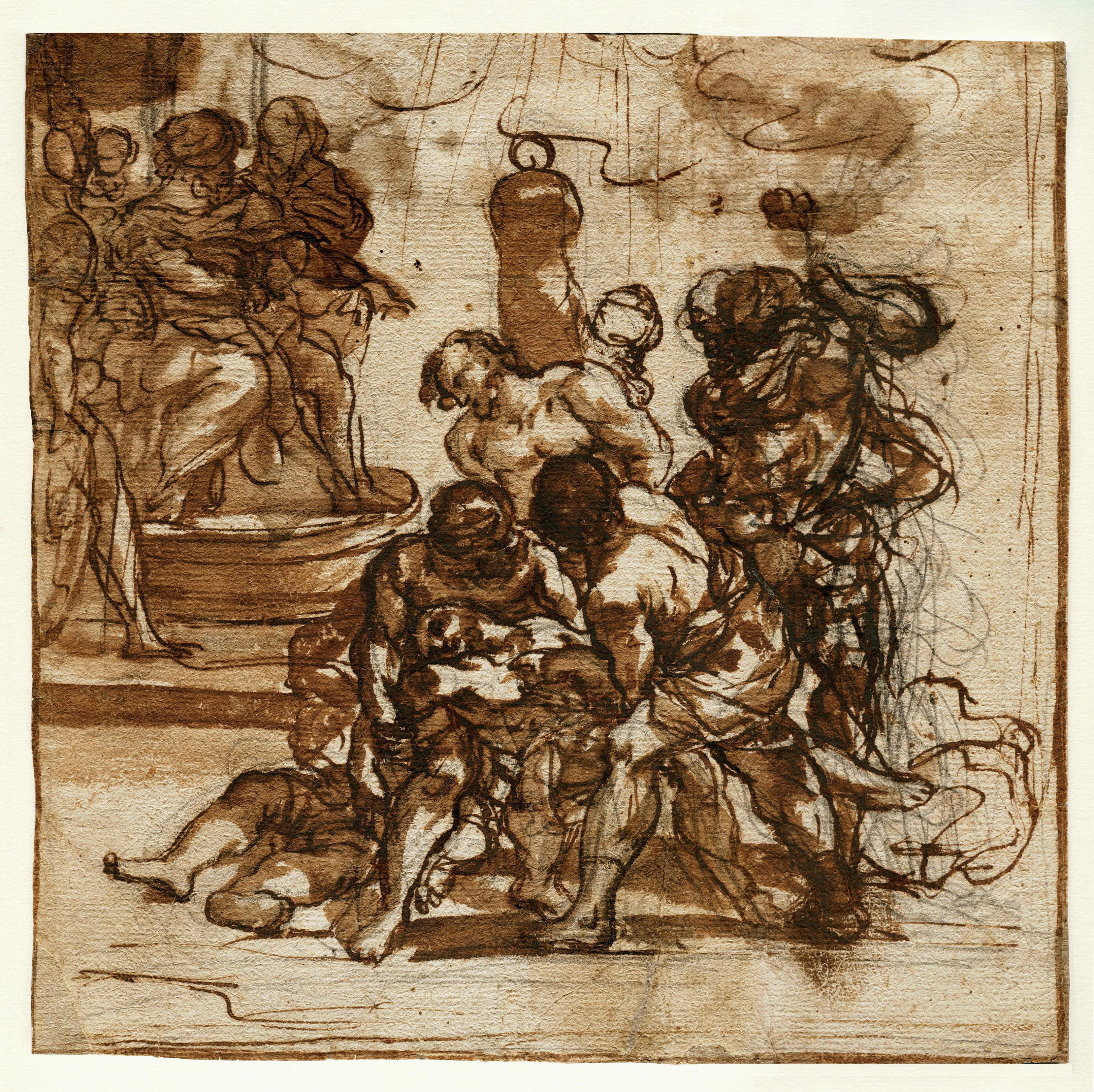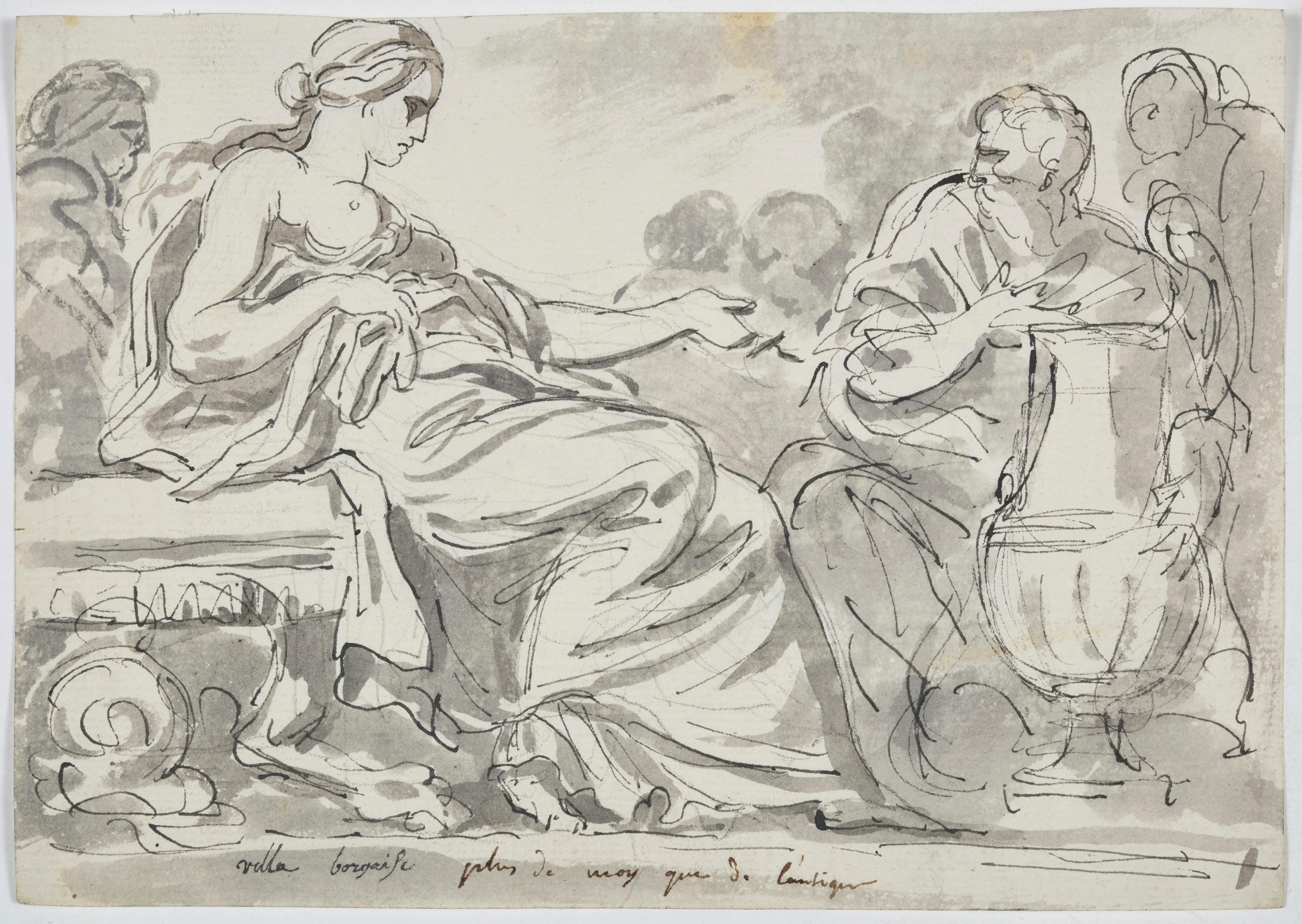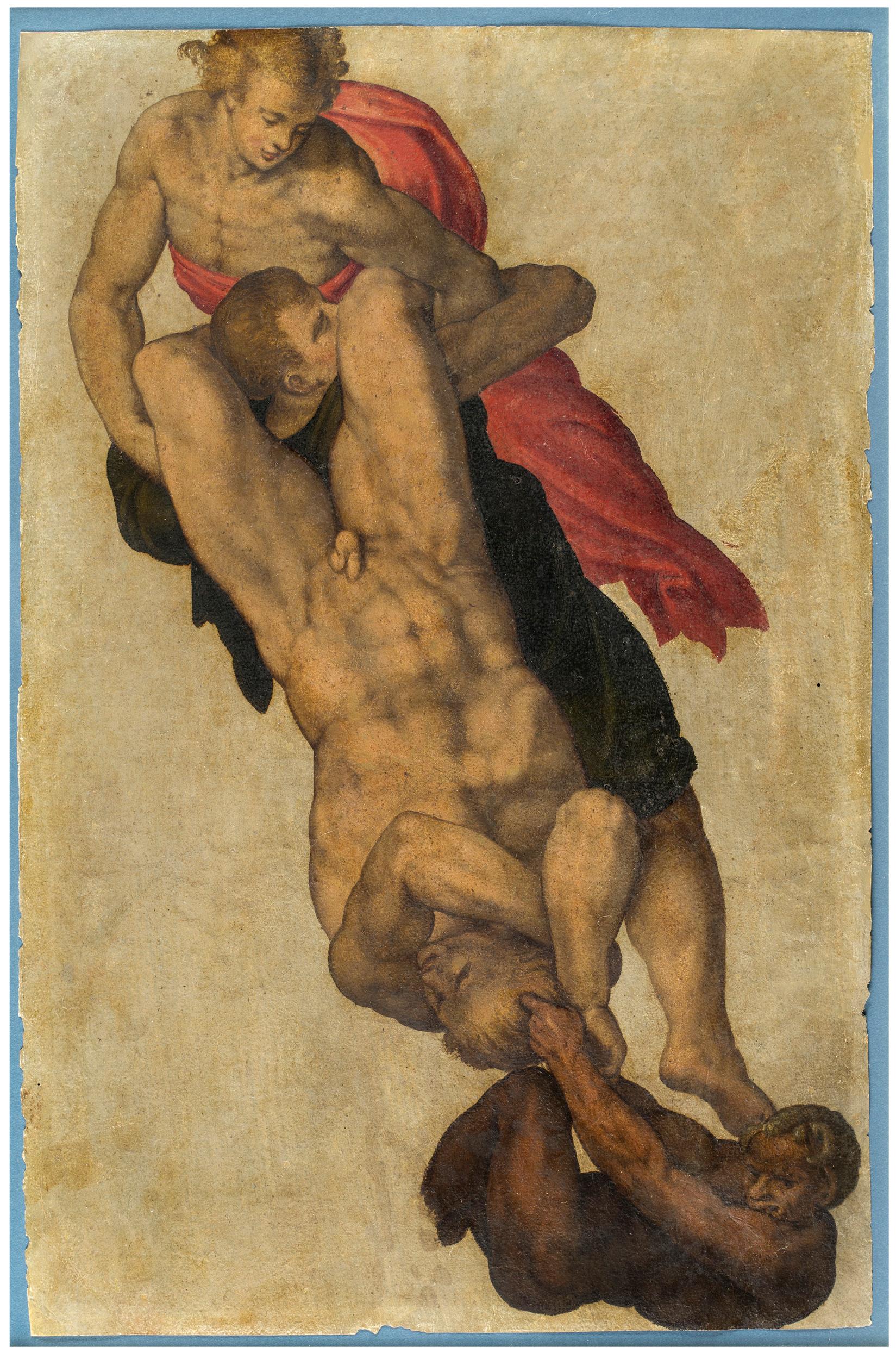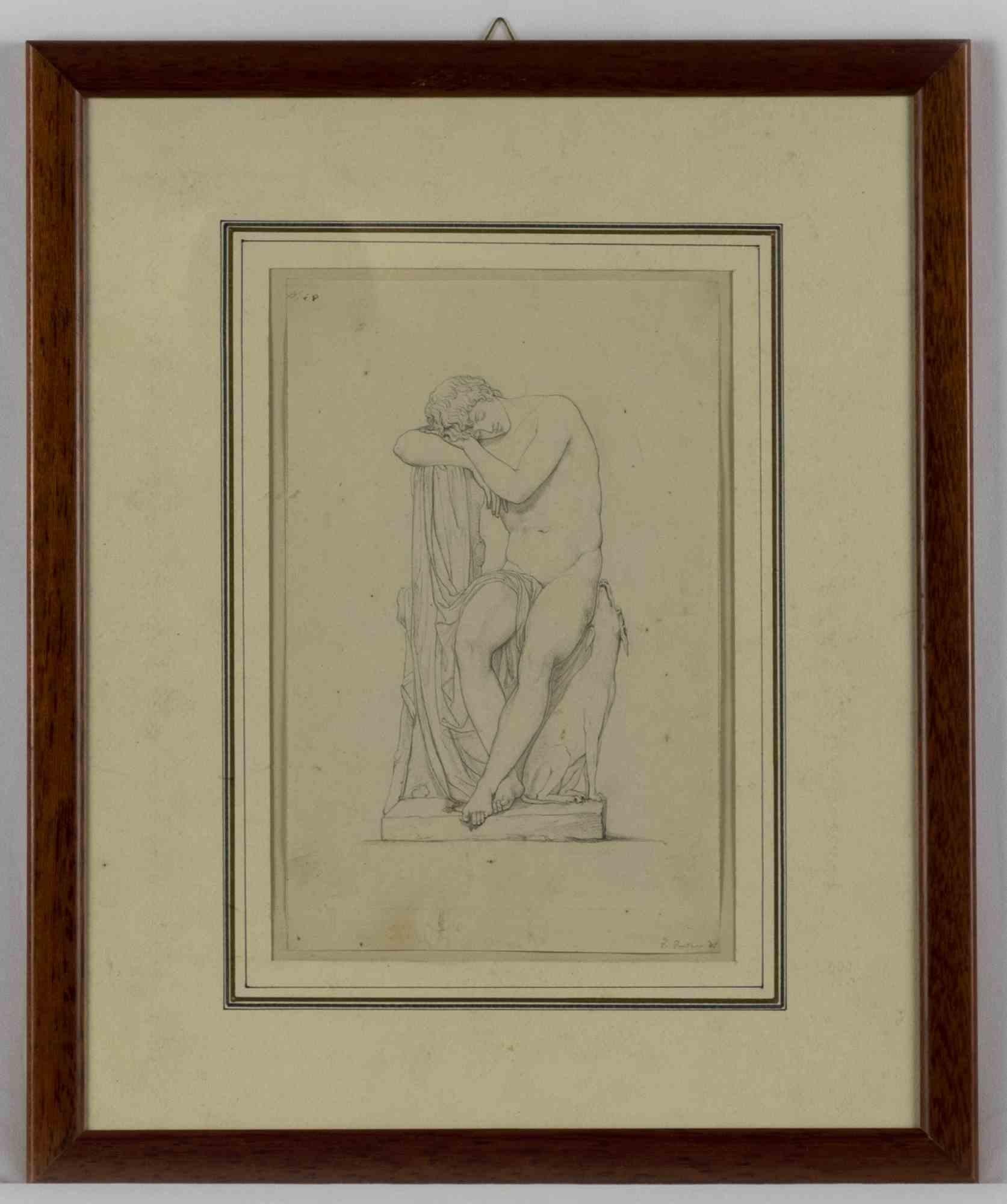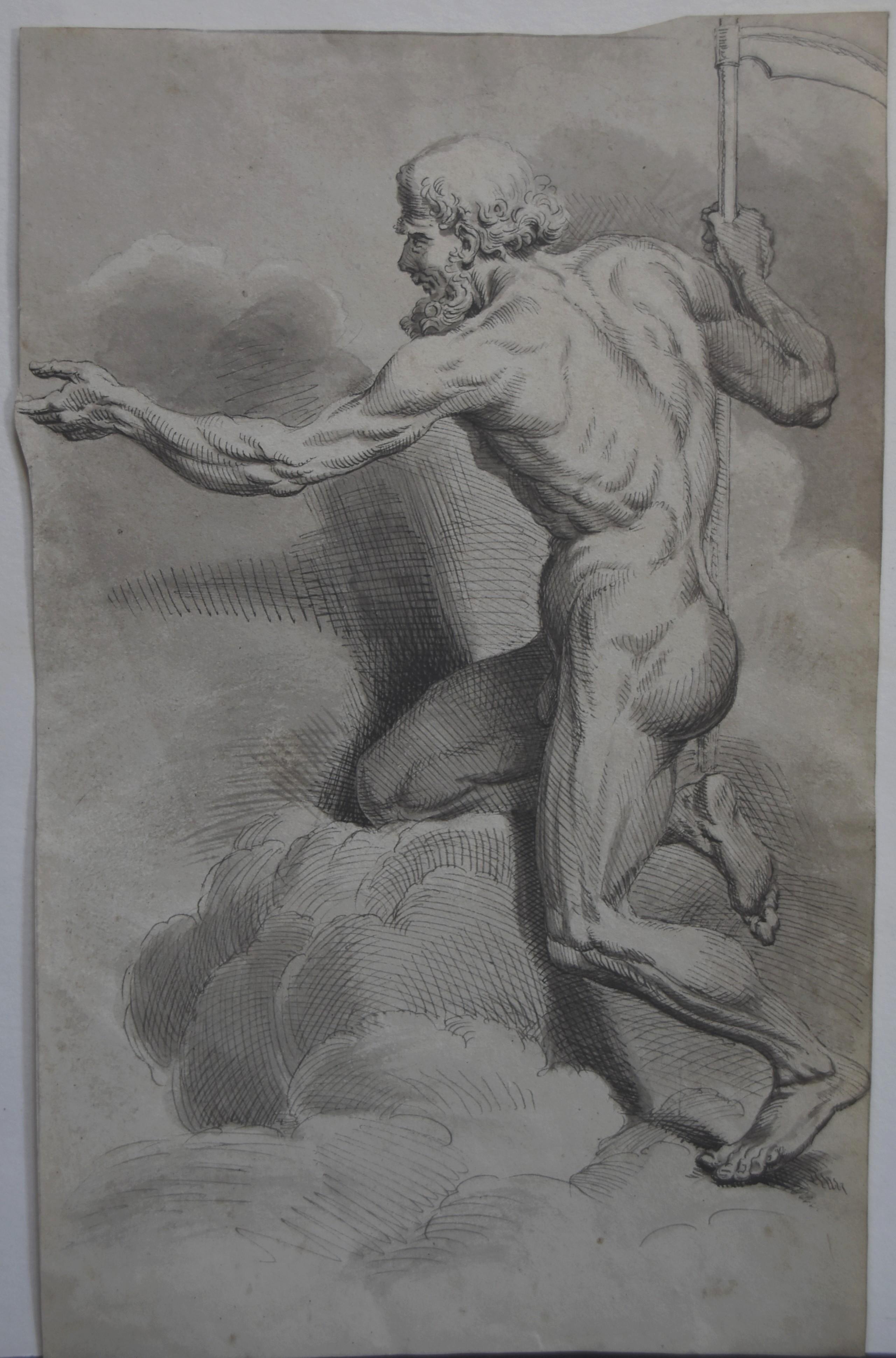Items Similar to Study of a Fate at mid-body, a red chalk attributed to Giovanni da San Giovanni
Want more images or videos?
Request additional images or videos from the seller
1 of 8
Study of a Fate at mid-body, a red chalk attributed to Giovanni da San GiovanniCirca 1635
Circa 1635
About the Item
This spectacular red chalk drawing depicts an elderly woman, her eyes bulging, her hand stretched out towards the sky. This disturbing character, who seems close to dementia, and the elongation of her arm with its Mannerist overtones, plunge us into the Florentine artistic milieu of the first half of the 17th century. The proximity of this drawing to some characters in the fresco in the Pitti Palace representing The Muses, Poets and Philosophers chased from Parnassus, the last masterpiece of Giovanni da San Giovanni, leads us to propose an attribution to this artist and a dating of around 1635-1636.
1. Giovanni da San Giovanni, the painter of contradiction
We take here the title of the monography dedicated to the artist by Anna Banti in 1977, which remains the reference book for this artist. The son of a notary, Giovanni Mannozzi, known as Giovanni da San Giovanni, abandoned his studies to go to Florence at the age of sixteen, where he entered the studio of Matteo Rosselli (1578 - 1650) around 1609 and enrolled in the Academy of Drawing Arts in 1612. Around 1615 he produced his first known works, mainly frescoes for the city's tabernacles. He became famous in Florence for his originality, combining an obsessive application to the study of drawing and the reading of poetry and history with a disheveled appearance. Between 1619 and 1620 he decorated the facade of the Antella Palace in Piazza Santa Croce, a decoration that still partly survives today.
The death of Cosimo II in 1621 put an end to the Florentine building activity and Giovanni da San Giovanni left for Rome to find other sponsors with the painter Francesco Furini. In particular, he made friends with Cardinal Guido Bentivoglio, for whom he decorated several rooms in his palace, which led him to leave Rome in 1628 to decorate the Bentivoglio family's palace in Gualtieri in Emilia Romagna.
After a few years spent on various building sites in the Tuscan countryside, he returned to the Medici orbit around 1633, creating a ceiling for Christine de Lorraine at her villa La Quiete. In 1635 he received his last official commission: on the occasion of his marriage to Vittoria della Rovere, Ferdinand II de' Medici entrusted him with the decoration of a large room, also known as the Salone degli Argenti, in the summer appartment on the ground floor of the Palazzo Pitti.
Giovanni da San Giovanni and his assistants (among them the young and promising Volterrano) decorated the ceiling and the vast wall opposite the windows with frescoes celebrating the glory of the Medici family. However, Giovanni da San Giovanni preferred to accept another project with Lorenzo Pucci before completing the decoration of this room; he was then dismissed by the Grand Duke and deprived of his income. Very affected by his disgrace, he died on December 9th, 1636, aged forty-four, of a badly treated gangrene in his knee.
2. Description of the red chalk drawing
The interpretation of our drawing is difficult: an elderly woman with messy hair and a desperate look in her eyes, her back slightly arched, holds a leaflet in her right hand while her left arm rises in the air, as if to take Heaven to task. The whole character is treated with great elegance and the masterly aspect of this slightly derisory movement is further reinforced by the elongation of the arm in relation to the rest of the body.
The presence of a leaf in her right hand could link this representation to that of Morta (Atropos in Greek), one of the three Fates who is sometimes represented reading the book of life, or cutting the thread of life.
3. Related artworks
We have not found any work directly related to this drawing, but the character seems to us to be quite close to the dishevelled harpy represented behind the poetess Sapho, who flees with a violin in her hand, in the fresco representing The Muses, the Poets and the Philosophers chased from Parnassus take refuge in Tuscany (seventh photo of the Gallery). This fresco was executed between 1635 and 1636 by Giovanni de San Giovanni on the eastern wall of the Salone degli Argenti in the Pitti Palace in Florence.
To be noted is the disproportionate length of the harpy's arm.
The three Fates are also represented on the ceiling of the same room (last photo of the Gallery), and this time the terrible Morta appears with her arms outstretched and her terrifying face, cutting an oak branch, under the protection of Juno and Venus, and thus accomplishing the union between the Medici family and that of the della Rovere (whose name means oak in Italian).
We also find in a detached fresco from Palazzo Pucci depicting Night and Dawn , one of Giovanni da San Giovanni's last works, a figure with her arm outstretched and her bosom bared. Although this is a beautiful young woman and not a terrifying old one, it is interesting to note that this relatively unusual pose recurs very repeatedly in Giovanni da San Giovanni's last works, justifying in our view the attribution of our sanguine to this artist and a proposed dating of around 1635-1636.
4. Provenance
This drawing comes from the collection of Doctor Gaud, a medical doctor born on July 18th, 1940 in Saint-Tropez, who sold most of his collection at Sotheby's in Monaco on June 20th, 1987, and then a few other drawings (which included this drawing) at the Piasa sale on March 26th 2010. He was particularly interested in Italian drawings from the Renaissance to the Baroque period, favouring singular pieces by little known artists.
This drawing is sold unframed but we can propose some framing options.
Main bibliographical references :
Anna Banti - Giovanni da San Giovanni pittore della contraddizione - Sansoni Firenze 1977
Silvia Benassai - Mara Visonà Quiete invenzione e inquietudine - Centro Di Firenze 2011
- Attributed to:Giovanni Mannozzi, called Giovanni da San Giovanni (1592 - 1636, Italian)
- Creation Year:Circa 1635
- Dimensions:Height: 10 in (25.4 cm)Width: 7.75 in (19.69 cm)
- Medium:
- Movement & Style:
- Period:
- Framing:Framing Options Available
- Condition:Red chalk – 10” x 7 3/4” (255 x 196 mm) - Framed: 16 5/16” x 14” (41.5 x 35.5 cm) Provenance: Michel Gaud (stamp lower left L. 3482) - Piasa sale on March 26th, 2010 (lot 5).
- Gallery Location:PARIS, FR
- Reference Number:1stDibs: LU1568211886102
About the Seller
5.0
Vetted Seller
These experienced sellers undergo a comprehensive evaluation by our team of in-house experts.
Established in 2020
1stDibs seller since 2021
8 sales on 1stDibs
Typical response time: 2 hours
- ShippingRetrieving quote...Ships From: PARIS, France
- Return PolicyA return for this item may be initiated within 3 days of delivery.
More From This SellerView All
- Three drawings by François Boucher in a mounting by Jean-Baptiste GlomyBy François BoucherLocated in PARIS, FRWe would like to thank Juliette Parmentier-Courreau of the Custodia Foundation for her welcome and support during the consultation of Glomy’s Journal des Ouvrages. This spectacularly large "feuille de desseins ajustés" commissioned by François Boucher from Jean-Baptiste Glomy is emblematic of the painter's art and mastery of rocaille. It is also fully representative of the taste of this period in the field of decorative arts. The largest of these three drawings, placed at the bottom of the composition, is particularly interesting: dating from around 1756, it constitutes a modello (apparently unpublished) for the frontispiece of the "Catalogue des tableaux de Monsieur de Julienne"), preserved in the Morgan Library in New York. 1. François Boucher, the master of French rocaille The extraordinary career of Francois Boucher was unmatched by his contemporaries in versatility, consistency and output. For many, particularly the writers and collectors who led the revival of interest in the French rococo during the last century, his sensuous beauties and plump cupids represent the French eighteenth century at its most typical. His facility with the brush, even when betraying the occasional superficiality of his art, enabled him to master every aspect of painting – history and mythology, portraiture, landscape, ordinary life and, as part of larger compositions, even still life. He had been trained as an engraver, and the skills of a draftsman, which he imbued in the studio of Jean-Francois Cars (1661 – 1738), stood him in good stead throughout his career; his delightful drawings are one of the most sought-after aspects of his oeuvre. As a student of Francois Lemoyne (1688 - 1737), he mastered the art of composition. The four years he spent in Italy, from 1727-1731, educated him in the works of the masters, classics and history, that his modest upbringing had denied him. On his return to Paris in 1734, he gained full membership of the Royal Academy of Painting and Sculpture with his splendid Rinaldo and Armida (Paris, Musée du Louvre). Although, throughout his career, he occasionally painted subjects taken from the Bible, and would always have considered himself first as a history painter, his own repertoire of heroines, seductresses, flirtatious peasant girls and erotic beauties was better suited to a lighter, more decorative subject matter. His mastery of technique and composition enabled him to move from large scale tapestry...Category
1750s Old Masters Figurative Drawings and Watercolors
MaterialsChalk, Ink
- Study in the Antique Style, a neoclassical drawing by Augustin PajouLocated in PARIS, FRIn this lively and fresh drawing, probably taken from one of the artist's notebooks, Pajou presents us with a composition freely inspired by antiquity, as a souvenir of a visit to th...Category
1750s Old Masters Figurative Drawings and Watercolors
MaterialsInk
- Astraea, a study for the Golden Age fresco at Dampierre by IngresBy Jean-Auguste-Dominique IngresLocated in PARIS, FRThis beautiful drawing, of great technical virtuosity, is one of the many studies made by Ingres for Astraea, one of the key characters in the Golden Age fresco he painted between 18...Category
1840s Old Masters Nude Drawings and Watercolors
MaterialsInk, Pen, Pencil, Carbon Pencil
- Soldier begging for Mercy a preparatory study by Jean-Marc Nattier (1685 - 1766)By Jean-Marc NattierLocated in PARIS, FRThis rare drawing by Nattier is part of a set of preparatory studies executed in 1717 for one of the painter's first commissions, the painting commissioned by Tsar Peter I of Russia ...Category
1710s Old Masters Figurative Drawings and Watercolors
MaterialsChalk
- A red chalk study sheet by Baldassare Franceschini, known as VolterranoLocated in PARIS, FRThis fresh sanguine sheet presents various studies placed next to each other in no apparent order. Two of the feet studies are preparatory to the first major commission received by the young Baldassare Franceschini, shortly after his installation in Florence, the frescoes for the Medici Fastes. This cycle was executed between 1636 and 1646 for the Villa La Petraia, a Medici villa on the outskirts of Florence, which allows us to date this sheet to the artist's youth. 1. The Medici Fastes, the first major commission for a young artist Born in Volterra in 1611, the town from which he took his nickname, Baldassare Franceschini apprenticed with his father, a sculptor of alabaster, one of his home town's specialities, and studied with Cosimo Daddi (1540-1630), a local artist. The Marquis Inghirami, who spotted his talent, sent him to the workshop of Matteo Rosselli (1578 - 1650) in Florence, which was also attended by Francesco Furini (1603 - 1646). In 1636, Lorenzo de' Medici, the youngest son of Ferdinand Ier and Christine of Lorraine, chose the 25-year-old artist, again on the advice of the Marquis Inghirami, to decorate with frescoes the loggias of the inner courtyard of the Villa La Petraia, which he had just inherited on the death of his mother. The project lasted about ten years and included ten scenes placed symmetrically in two loggias on either side of the courtyard: four main scenes and six placed above the doors, each to the glory of a member of the Medici family. This decoration was his major secular project, but Volterrano also executed several religious frescoes and a few easel paintings, often with less success. Among the religious commissions, we can cite the dome of the Colloredo chapel dedicated to Saint Lucy...Category
Mid-17th Century Old Masters Figurative Drawings and Watercolors
MaterialsChalk, Paper
- The Arab Butcher, a preparatory drawing by Gustave Guillaumet (1840 - 1887)Located in PARIS, FRThis intensely expressive figure is a preparatory study for "Arab Market on the Tocria Plain", a painting exhibited at the 1865 Salon and now in the Musée des Beaux-Arts in Lille. 1...Category
1860s Old Masters Figurative Drawings and Watercolors
MaterialsCarbon Pencil, Chalk
You May Also Like
- The Martyrdom of the Santi Quattro CoronatiLocated in New York, NYProvenance: Private Collection, UK After initial training under Justus Suttermans and Vincenzo Dandini, in 1673 Anton Domenico Gabbiani embar...Category
17th Century Old Masters Figurative Drawings and Watercolors
MaterialsPaper, Chalk, Ink, Pen
- Study after Michelangelo’s “The Last Judgment”By Michelangelo BuonarrotiLocated in New York, NYItalian School, 16th Century Provenance: Private Collection, New York This intriguing drawing is a study by an anonymous 16th-century Italian artist after a vignette in Michelangelo’s fresco of The Last Judgement in the Sistine Chapel. The altar wall of the Sistine Chapel was already richly decorated when Pope Clement VII commissioned Michelangelo to paint his Last Judgment...Category
16th Century Old Masters Figurative Drawings and Watercolors
MaterialsPaper, Gouache
- Sleeping Boy - Drawing by Giovanni Fontana - 16th CenturyLocated in Roma, ITSleeping Boy is an original modern artwork realized in the 16th century by Giovanni Fontana. Ivory colored sheet attached on an ivory colored cardboard (...Category
16th Century Old Masters Figurative Drawings and Watercolors
MaterialsPaper, Pencil
- French Neo classical school, Allegory of Time, original drawingLocated in Paris, FRNeo classical school, France, end of the 18th Century Allegory of Time, Pen and black ink on paper, gray ink wash 30.5 x 19 cm irregularly shaped In g...Category
1790s Old Masters Nude Drawings and Watercolors
MaterialsIndia Ink
- Louis-Félix de La Rue (1730-1777) A Mythological scene, drawingBy Louis-Félix DelarueLocated in Paris, FRLouis-Félix de La Rue (1730-1777) A Mythological scene Pen and black ink on paper Bears an old inscription with the name of the artist on the lower left bo...Category
1770s Old Masters Figurative Drawings and Watercolors
MaterialsInk
- French School, Academic Study (Male Nude)Located in London, GBCharcoal on paper, 60cm x 42cm, (74cm x 60cm framed). The picture is framed behind museum quality non-reflective UV glass. Drawings and paintings of the nude were central to academ...Category
19th Century Old Masters Nude Drawings and Watercolors
MaterialsPaper, Carbon Pencil
Recently Viewed
View AllMore Ways To Browse
Antique Body
To Young To Die
Large Study Of A Leaf
Antique Drawing Book
Old Master Italian Drawings
Old Book Ends
San Louis
Drawings Italian 18th Century
Old Master Drawings Framed
Red Figure Study
Drawing Branch
Large Nude Drawing
Drawings Body Movement
Rooms To Go
Large Framed Painting Nude
Drawing With Chalk
Italian Villa Drawing
Drawing Rooms
